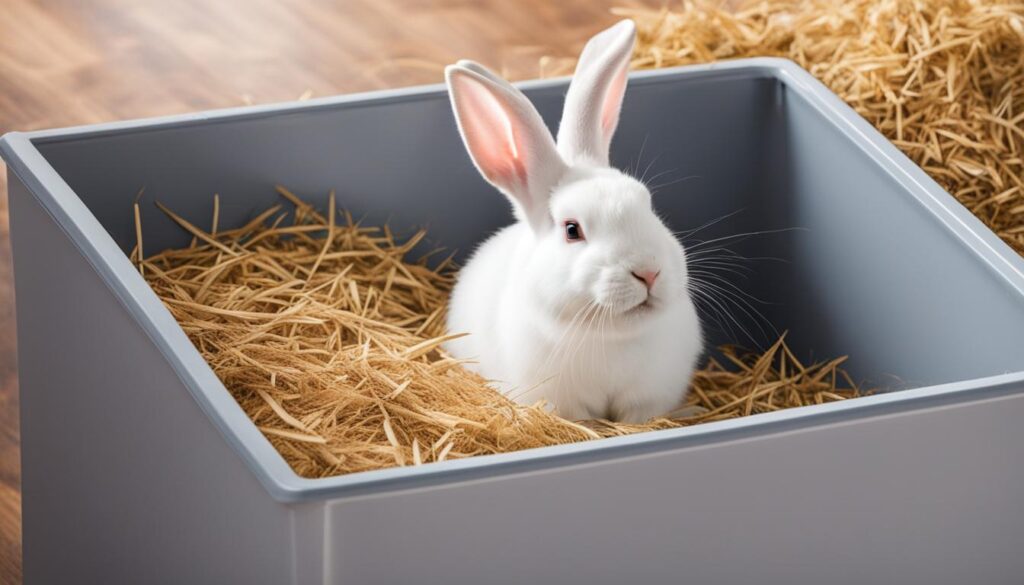Litter training rabbits is an important aspect of their care and can help create a clean and happy environment for your pet. According to the Oakville and Milton Humane Society (OMHS), rabbits are like curious, long-eared puppies and can be amazing pets with the right care, attention, and training. OMHS recommends providing plenty of toys to keep rabbits mentally stimulated. All rabbits available for adoption at OMHS come spayed or neutered and microchipped for easy identification. The shelter provides training and equipment for those looking to foster a rabbit, including food, a litter box with litter, a pen, bedding, and water bowls.
Key Takeaways:
- Litter training is important for creating a clean environment for your rabbit.
- Rabbits are curious animals that can be great pets with proper care and training.
- Providing toys and mental stimulation is essential for rabbits.
- OMHS offers training and equipment for adopting or fostering a rabbit.
The Benefits of Litter Training Your Rabbit
Litter training rabbits offers several benefits. It helps keep their living space clean and prevents them from soiling other areas of the house. Additionally, litter training makes it easier to bond with your rabbit, as they will have designated areas for elimination. This can also help prevent behavioral issues such as chewing on furniture or carpet. To successfully litter train your rabbit, provide a litter box filled with rabbit-safe litter and place it in a corner of their enclosure. Reinforce positive behavior by providing treats and praise when they use the litter box correctly.
The Benefits of Litter Training Your Rabbit:
| Benefits | Description |
|---|---|
| 1. Clean living space | Litter training prevents rabbits from soiling other areas of the house, keeping their environment tidy. |
| 2. Easier bonding | Rabbits with designated elimination areas are easier to bond with, creating a stronger human-rabbit connection. |
| 3. Prevention of behavioral issues | By providing rabbits with a designated litter box, it helps prevent them from chewing on furniture or carpet. |
| 4. Positive reinforcement | Using treats and praise when rabbits use the litter box correctly reinforces their good behavior. |
In addition to the practical benefits, litter training your rabbit also contributes to a happier and healthier living environment. It reduces the risk of unsanitary conditions and potential health issues related to soiling outside the litter box. By following the proper techniques and consistently reinforcing good litter box habits, you can successfully train your rabbit to use a litter box and enjoy the many advantages it offers.
Choosing the Right Litter for Rabbit Training
When it comes to litter training your rabbit, selecting the right litter is crucial for their health and comfort. Avoid clumping or dusty litters, as they can be harmful if ingested. Instead, opt for safe and absorbent options that are specifically designed for rabbits.
Paper-Based Litters
Paper-based litters are an excellent choice for rabbit training. They are made from recycled paper and are highly absorbent, keeping your rabbit’s living space clean and odor-free. These litters are also dust-free, which is beneficial for rabbits with respiratory sensitivities.
Wood Pellet Litters
Wood pellet litters, made from compressed wood fibers, are an eco-friendly option that absorbs moisture effectively. They are low in dust and provide good odor control. However, some rabbits may be hesitant to use them due to their texture, so it’s essential to monitor your rabbit’s behavior when introducing this type of litter.
Hemp Litters
Hemp litters are an increasingly popular choice for rabbit training. They are made from the fibrous stalks of the hemp plant, providing superior absorbency and odor control. Hemp litters are also biodegradable and eco-friendly, making them a sustainable option for responsible pet owners.
Remember, every rabbit is unique, and their litter preferences may vary. It’s a good idea to experiment with different litter types to find the one that your rabbit feels most comfortable using. By choosing a safe and suitable litter, you can ensure a clean and hygienic environment for your furry friend.
| Litter Type | Pros | Cons |
|---|---|---|
| Paper-Based Litters | Highly absorbent | May require frequent changes |
| Wood Pellet Litters | Eco-friendly, good odor control | Some rabbits may not like the texture |
| Hemp Litters | Superior absorbency, biodegradable | Can be more expensive |
In summary, choosing the right litter for rabbit training is essential for their well-being. Paper-based litters, wood pellet litters, and hemp litters are all safe options that provide good absorbency and odor control. Remember to observe your rabbit’s preferences and behavior when introducing a new litter type. Maintaining a clean litter box with the appropriate litter will help ensure a happy and healthy litter-trained rabbit.
Introducing the Litter Box to Your Rabbit
When it comes to litter training your rabbit, the first step is to introduce them to the litter box. Start by placing the litter box in a corner of their enclosure or the area where they tend to eliminate. Rabbits are naturally clean animals and often have a preferred spot for elimination. To help them recognize the litter box as their toilet area, you can place some of their droppings in the box. Additionally, using a small amount of hay in the litter box can entice them to enter and explore.
Gradually reducing the amount of hay outside the litter box will encourage your rabbit to consistently use it. It’s important to be patient during this process and avoid scolding or punishing your rabbit if they have accidents outside the litter box. Instead, focus on positive reinforcement by offering treats and praise when they use the litter box correctly. With time and consistency, your rabbit will learn to associate the litter box with their toilet area.
Creating a Comfortable Litter Box Setup
Creating a comfortable litter box setup is essential for the success of litter training your rabbit. Choose a litter box that is large enough for your rabbit to comfortably move around and easily enter. A low-sided litter box is ideal for rabbits, as it allows them to hop in and out easily. You can also place a layer of litter in the box to absorb moisture and odors.
Keep in mind that rabbits are known for their tendency to kick and scatter litter. To minimize this, consider using a litter box with higher sides or attach a litter box guard to prevent litter from being kicked out. It’s important to regularly clean the litter box to maintain hygiene and prevent odors. By creating a comfortable and clean litter box setup, you’ll provide an optimal environment for your rabbit to learn and reinforce good litter box habits.
| Litter Box Set Up Tips | Benefits |
|---|---|
| Choose a large litter box | Allows your rabbit to move comfortably |
| Use a low-sided litter box | Easy for your rabbit to hop in and out |
| Add a layer of litter | Absorbs moisture and odors |
| Consider a litter box guard | Prevents litter from being kicked out |
| Regularly clean the litter box | Maintains hygiene and prevents odors |
By following these steps and tips, you can effectively introduce the litter box to your rabbit and create a comfortable setup for successful litter training. Remember to be patient, consistent, and provide positive reinforcement during the process. With time and effort, your rabbit will develop good litter box habits and enjoy a clean and litter-trained life.
Reinforcing Good Litter Box Habits
Once your rabbit starts using the litter box, it’s important to reinforce good litter box habits. Consistency and positive reinforcement are key to maintaining successful rabbit potty training. Here are some tips to help you in maintaining rabbit litter box habits:
1. Clean the Litter Box Regularly:
To prevent odors and maintain cleanliness, clean the litter box regularly. Remove any soiled litter and replace it with fresh litter. A clean litter box will encourage your rabbit to continue using it.
2. Provide Hay in or near the Litter Box:
Rabbits are more likely to use the litter box if there is a food source nearby. Placing hay in or near the litter box will attract your rabbit and make them more inclined to use it.
3. Address Accidents Promptly:
If your rabbit has accidents outside the litter box, clean the area thoroughly and place some of their droppings in the litter box to remind them of the proper location. Avoid scolding or punishing your rabbit, as this can undermine the trust-building process.
4. Be Consistent:
Ensure your rabbit’s litter box is always in the same location. Rabbits prefer to eliminate in the same spot, so keeping the litter box consistent will help them reinforce good habits.
By following these tips, you can maintain good litter box habits and ensure a clean and comfortable environment for your rabbit.
| Tip | Description |
|---|---|
| Clean the Litter Box Regularly | Remove soiled litter and replace with fresh litter to maintain cleanliness and prevent odors. |
| Provide Hay in or near the Litter Box | Having hay nearby will attract your rabbit to the litter box and encourage proper usage. |
| Address Accidents Promptly | Thoroughly clean any accidents outside the litter box and place droppings in the box as a reminder. |
| Be Consistent | Keep the location of the litter box consistent to reinforce good habits in your rabbit. |
Troubleshooting Litter Training Challenges
While litter training your rabbit can be a rewarding experience, it may also come with its fair share of challenges. Understanding and overcoming these issues is essential for successful litter training. Here are some common litter training issues faced by rabbit owners and tips for overcoming them:
1. Consistent Elimination Outside the Litter Box
If your rabbit consistently eliminates outside the litter box, it may be because they have not yet associated the box with the appropriate toilet area. To address this, consider placing additional litter boxes in different areas that your rabbit prefers to eliminate. This will accommodate their preferences and increase the chances of successful litter training.
2. Litter Scattering and Digging
Rabbits are natural diggers, and it’s not uncommon for them to scatter litter outside the box. To prevent this, you can use a larger, deeper litter box that provides more space for digging. Another option is to attach a litter box guard, which acts as a barrier to prevent litter from being kicked out. These solutions can help minimize litter scattering and keep the area around the box cleaner.
3. Reluctance to Use the Litter Box
If your rabbit shows resistance to using the litter box, it may be helpful to consult with a veterinarian or a rabbit behavior specialist. They can provide expert guidance tailored to your rabbit’s specific needs. It’s important to address any underlying issues that may be causing the reluctance and work towards finding a solution that works for both you and your rabbit.
| Common Litter Training Issues | Tips for Overcoming Them |
|---|---|
| Consistent elimination outside the litter box | Place additional litter boxes in different areas |
| Litter scattering and digging | Use a larger, deeper litter box or attach a litter box guard |
| Reluctance to use the litter box | Consult with a veterinarian or rabbit behavior specialist |
By addressing these common challenges and implementing the suggested solutions, you can overcome litter training problems and help your rabbit develop good litter box habits. Remember, patience and consistency are key, and with time, your rabbit will become more accustomed to using the litter box effectively.
Rabbit-Proofing Your Home and Providing Enrichment for Rabbits
Creating a rabbit-friendly environment is essential to ensure the safety and well-being of your furry friend. Rabbit-proofing your home is the first step in preventing any accidents or injuries. Start by securing electrical cords and wires, as rabbits have a tendency to chew on them. Use cord protectors or cover them with plastic tubing to make them less accessible. It’s also important to remove any toxic plants or substances from your rabbit’s reach, as they can be harmful if ingested. Lastly, block off any areas where your rabbit could get stuck or injured, such as small openings or gaps in furniture.
Providing enrichment for your rabbit is equally important for their mental stimulation and physical exercise. Toys are a great way to keep them entertained and prevent boredom. Choose toys that are safe for rabbits, such as chew toys made from natural materials like applewood or willow. Interactive toys like treat puzzles can also provide mental stimulation and encourage natural behaviors. Additionally, tunnels and hideaways offer a sense of security and encourage exploration. It’s important to rotate toys regularly to keep your rabbit engaged and prevent them from becoming bored with their environment.
Table: Rabbit-Safe Toys and Enrichment Ideas
| Toys | Benefits |
|---|---|
| Chew toys made from applewood or willow | Helps to keep teeth healthy and prevents destructive chewing |
| Treat puzzles | Provides mental stimulation and encourages problem-solving |
| Tunnels and hideaways | Offers a sense of security and encourages exploration |
| Paper bag or cardboard box | Offers a simple and inexpensive hiding spot for rabbits to play in |
| Untreated willow or seagrass baskets | Provides a safe and chewable place for rabbits to hide and rest |
By rabbit-proofing your home and providing enrichment for your rabbit, you can create a safe and stimulating environment for them to thrive in. Remember to always supervise your rabbit during playtime and regularly inspect their toys for any signs of damage or wear. With these precautions in place, you can ensure that your rabbit remains happy, healthy, and entertained.
Tips for Successful Rabbit Litter Training
Litter training your rabbit requires patience and consistency, but with the right techniques, you can successfully train your furry friend to use a litter box. Here are some valuable tips to help you achieve success:
- Choose the right litter: Opt for rabbit-safe litters such as paper-based, wood pellet, or hemp litters. Avoid clumping or dusty litters that can harm your rabbit if ingested.
- Introduce the litter box gradually: Place the litter box in a corner of your rabbit’s enclosure or in the area they prefer for elimination. Add some of their droppings and a small amount of hay to entice them to use the litter box.
- Reinforce positive behavior: Reward your rabbit with treats and praise when they use the litter box correctly. This helps them associate the litter box with positive experiences.
- Be consistent: Place the litter box in the same spot consistently. Avoid using strong-smelling cleaners near the litter box, as this may discourage your rabbit from using it.
By following these tips, you can establish good litter box habits for your rabbit and create a clean and comfortable environment for both of you.
Maintaining Good Litter Box Hygiene
Keeping your rabbit’s litter box clean is essential for their health and well-being. Regular maintenance not only prevents odor buildup but also helps maintain a clean environment for your rabbit. Here are some tips for maintaining good litter box hygiene:
- Regular Cleaning: Remove any soiled litter from the litter box daily. Scoop out any droppings or wet spots and replace them with fresh litter. This will help prevent odors and keep the litter box clean.
- Thorough Cleaning: Periodically, give the litter box a thorough cleaning. Empty the litter box completely and wash it with a rabbit-safe disinfectant. Rinse it thoroughly and allow it to dry before adding fresh litter.
- Safe Cleaning Products: When cleaning the litter box, use rabbit-safe cleaning products. Avoid using strong-smelling or harsh chemicals, as they may irritate your rabbit’s sensitive respiratory system. Opt for mild, non-toxic cleaners to ensure your rabbit’s safety.
Proper litter box hygiene also involves providing enough space for your rabbit to comfortably use the litter box. Ensure that the litter box is large enough for them to move around and eliminate without restrictions. This helps prevent accidents and encourages your rabbit to use the designated area for elimination.
By maintaining good litter box hygiene, you can ensure a clean and odor-free space for your rabbit while promoting their overall health and happiness.
Conclusion
In conclusion, litter training your rabbit is an important aspect of their care that offers numerous benefits. By following the techniques and tips outlined in this guide, you can successfully train your rabbit to use a litter box, creating a clean and harmonious environment for both you and your pet.
Remember to be patient and consistent throughout the training process. Provide positive reinforcement, such as treats and praise, when your rabbit uses the litter box correctly. Avoid scolding or punishing your rabbit for accidents outside the litter box, as this can hinder the training progress and damage trust.
Maintaining good litter box hygiene is essential. Clean the litter box regularly, removing any soiled litter and replacing it with fresh litter. Use rabbit-safe disinfectants when necessary, and avoid strong-smelling cleaning products that may deter your rabbit from using the litter box. Providing ample space and a comfortable litter box size will also contribute to a successful training experience.
With time and effort, your rabbit will develop good litter box habits and enjoy a happy, litter-trained life. Enjoy the clean and convenient benefits of having a litter-trained rabbit as a part of your family!
FAQ
Why is litter training important for rabbits?
Litter training rabbits is important to create a clean and happy environment for your pet. It helps keep their living space clean, prevents them from soiling other areas of the house, and can prevent behavioral issues such as chewing on furniture.
What are the benefits of litter training my rabbit?
Litter training your rabbit has several benefits. It helps keep their living space clean, makes it easier to bond with your rabbit, and prevents behavioral issues. It also allows you to create designated areas for elimination, making it easier to manage their waste and keep your home clean.
What type of litter should I use for my rabbit?
The best litter options for rabbits include paper-based litters, wood pellet litters, and hemp litters. These types of litter are safe for rabbits and absorb moisture well. Avoid using clumping or dusty litters, as they can be harmful if ingested.
How do I introduce the litter box to my rabbit?
Place the litter box in a corner of their enclosure or the area where they tend to eliminate. Place some of their droppings in the litter box to help them recognize it as a toilet area. You can also use a small amount of hay to entice them to enter the litter box.
How can I reinforce good litter box habits in my rabbit?
Clean the litter box regularly to maintain cleanliness. Provide plenty of hay in or near the litter box, as rabbits are more likely to use it if there is a food source nearby. If accidents occur outside the litter box, clean the area thoroughly and place some of their droppings in the litter box to remind them of the proper location.
What should I do if my rabbit doesn’t use the litter box?
If your rabbit consistently eliminates outside the litter box, consider placing additional litter boxes in different areas to accommodate their preferences. If your rabbit shows resistance to using the litter box, consult with a veterinarian or a rabbit behavior specialist for guidance.
How can I create a rabbit-friendly environment?
Rabbit-proof your home by securing electrical cords, removing toxic plants, and blocking off areas where the rabbit could get stuck or injured. Provide plenty of enrichment for your rabbit, such as toys, tunnels, and puzzles, to keep them mentally stimulated and physically active.
What are some additional tips for successful rabbit litter training?
Be consistent with the placement of the litter box, avoid using harsh chemicals near the litter box, and provide plenty of positive reinforcement with treats and praise when your rabbit uses the litter box correctly.
How do I maintain good litter box hygiene?
Clean the litter box regularly, removing any soiled litter and replacing it with fresh litter. Use a rabbit-safe disinfectant to thoroughly clean the litter box periodically, and ensure the litter box is large enough for your rabbit to comfortably use.





